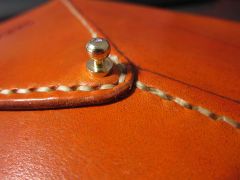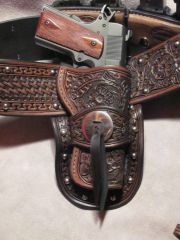-
Posts
390 -
Joined
-
Last visited
Content Type
Profiles
Forums
Events
Blogs
Gallery
Everything posted by LederRudi
-

Envelope style messenger bag
LederRudi commented on jacket potato's gallery image in Gallery- Our Leatherwork
-

Envelope style messenger bag
LederRudi commented on jacket potato's gallery image in Gallery- Our Leatherwork
-

Peacemaker Holster
LederRudi replied to Geronimo's topic in Gun Holsters, Rifle Slings and Knife Sheathes
Hi Danny, impressive carving on that quiver! The 7-1/2" Colt design fits nicely. It's as if you kept the carving on one side so as not to overcrowd the piece. Nice, clean work! As opposed to my own pieces that soetimes look like der Kuh aus dem Arsch gezogen (pulled out of a cow's ass). A while ago I've tried to create my own design for the jockstrap holster in Stohlman's book. I borrowed heavily from Bob Parks book on western floral design. Basically I forced two circles of one of the templates into the outline of the holster and added some small leaves and scrolls. I was rather pleased with the outcome but I botched the actual carving. Since then I'm suffering from posttraumatic stress disorder. Höchste Eisenbahn, noch einen Versuch zu machen und das Trauma zu überwinden (highest railway to have another go at it in order to overcome the trauma ). Beste Grüße nach Norddeutschland, Rudi -

Peacemaker Holster
LederRudi replied to Geronimo's topic in Gun Holsters, Rifle Slings and Knife Sheathes
Nicely done! I used the same pattern for one of my first stabs at holster-making. The outcome couldn't compete with yours. I only kept it to remind me how I started. Did you create the carving pattern by yourself? It's different from the two designs the book suggests. -

A New Experiment - 1911
LederRudi replied to immiketoo's topic in Gun Holsters, Rifle Slings and Knife Sheathes
It took me a while to realize that the basketweave literally is "carved" as opposed to "stamped". Fabulous work! What kind of a beveler did you use? Is it triangle-shaped? -
train toy ... that's a good guess! Through one of the discussions here on leatherworker.net I found http://www.leatherburnishers.com/Home_Page.html which also might be of interest for you.
-
I found them in the wood section together with dowels, globular furniture legs and the like. Another store might might be structured different or might not have such wheels in stock, and I'm speaking of Austrian hardware stores. But as far as my experience goes, American ones aren't any different from ours.
-
...but I'm pleased with this set auf slickers I made of wooden wheels that can be bought in hardware stores.
-

Double Layer Holster Ques
LederRudi replied to Boriqua's topic in Gun Holsters, Rifle Slings and Knife Sheathes
Thank you for responding, guys, and for describing your method, Rudi -

Double Layer Holster Ques
LederRudi replied to Boriqua's topic in Gun Holsters, Rifle Slings and Knife Sheathes
I just tried the method John Bianchi suggests, using 8-9/5-6 oz. In his video Bianchi speaks of skyving only some 1000ths of an inch. So I just broke the surface of the flesh-side with a french skyver and scraped off some of the liner. It worked well enough for me, although the inside of the fold doesn't feel as smoth as the rest because there are a lot of virtually unvisible micro-puckers. Could be, I should have skyved more, but then, why not use leather of half the thickness for the entire piece? So how much of a pucker do you tolerate? I'd actually prefer to glue the liner in when the outer shell is folded over. But then it's impossible to make a stitching groove on the inside. Bianchi doesn't bother with the backside neither of the gunbelt nor of the holster because he machine stitches. The ones who fold first and then glue: Do you make grooves on the inside? -
-

Armor For Samsung Tv Commercial Update
LederRudi replied to Prince's topic in Historical Reenactment
Awesome work! incredible indeed I'll give away my leathercraft tools! -

First Stab At A Lined Belt
LederRudi replied to LederRudi's topic in Purses, Wallets, Belts and Miscellaneous Pocket Items
I like this simple design too. I didn't invent it though. I've seen some variant or other posted here. And I've already ripped it off from Will Ghormley (http://www.willghormley-maker.com/MakingHOGRig.html). -

2Nd Photo Album Done
LederRudi replied to Double U Leather's topic in Books, Journals and Photo Albums
Awesome work! Something to aspire to! Rudi -

First Stab At A Lined Belt
LederRudi replied to LederRudi's topic in Purses, Wallets, Belts and Miscellaneous Pocket Items
Thank you for the input, Rory! Last summer I made an unlined belt for myself and also gave it only a coat of oil. The flesh-side absorbed a lot of sweat when I wore the belt in Turkey. Streaks of salt then showed on the grain-side as well. thus I learned that sealing of the inner side is indispensable. I didn't do any skyving on the belt I'm showing here. I don't like the idea of weakening the leather where most of the stress is to be expected. Since I thought of attaching a pouch that contains some essential items (money, credit cards, passport...) I wanted to be on the safe side and preferred screws over snaps. Leatherwork isn't very popular on our side of the pond, therefore I'm pretty dependent on Tandy UK when it comes to hardware or tools. Any import from the US would about double costs. That's a good idea to use the thicknesses of a square! Very simple - and I hadn't thought of it! Rudi -

First Stab At A Lined Belt
LederRudi replied to LederRudi's topic in Purses, Wallets, Belts and Miscellaneous Pocket Items
Danke for the compliment, Ray! Rudi -

First Stab At A Lined Belt
LederRudi replied to LederRudi's topic in Purses, Wallets, Belts and Miscellaneous Pocket Items
Thank you, Cheryl! Rudi -

Belts And A Pouch
LederRudi replied to Beneath The Stars's topic in Purses, Wallets, Belts and Miscellaneous Pocket Items
Beautiful, clean work! I especially love the construction of the pouch! -

First Stab At A Lined Belt
LederRudi replied to LederRudi's topic in Purses, Wallets, Belts and Miscellaneous Pocket Items
Thank you for your kind comment and advise, Rudi -
Always a pleasure and very inspiring to look at your work!
-

First Stab At A Lined Belt
LederRudi replied to LederRudi's topic in Purses, Wallets, Belts and Miscellaneous Pocket Items
In fact I did the stitching after dying and finishing, but you are right: it does look dirty. I think this is because the thread is heavily waxed. I thought I could get rid of the excessive wax by running a stitching wheel over the stitching afterwards, but that obviously didn't pan out. I've seen people melting away the superfluous wax with a lighter (is that standard procedure?) but I didn't like the idea of holding a flame to an artificial thread. The thread also dragged up some glue although there were more than 24 hours between glueing and stitching. Could it be that I applied too much glue or/and that I should have waited longer? In the forums here I've read pople going on about so-and-so-many strand linnen threads and the like. What would be the best choice for a project like mine (8-9 oz belt with 4-5 oz lining)? Thanks for your input Rudi -

First Stab At A Lined Belt
LederRudi replied to LederRudi's topic in Purses, Wallets, Belts and Miscellaneous Pocket Items
Thank you, Mike! -

First Stab At A Lined Belt
LederRudi replied to LederRudi's topic in Purses, Wallets, Belts and Miscellaneous Pocket Items
Thank you all for the input! ...I'll get a belt sander today! Buckle: The buckle is from Tandy. It's the only 1 3/4" buckle I could find on their website. I like its simplicity. Keeper: Since it's a center bar buckle it keeps the protruding end of the billet pretty close to the belt. Nevertheless I plan to add a keeper which is easily done since I used chicago screws. Layout: The layout of the stamping is based on Will Ghormleys "Hand of God Rig" pattern (http://www.willghormley-maker.com/MakingHOGRig.html). I replaced the Mule's Foot by a border tool which I found more easy to control. I had already botched a strap by carelessly stamping away which resulted in tilted Mule's Foot impressions and poor lineup of the two rows. It pays to follow Will Ghormley's instructions and to prepare the stamping with a square and a Wing Divider. Stitching: Instead of a stitching wheel I used diamond-shaped chisels (1, 2 and 4 prong) which I only tapped lightly. The actual stitching holes I created with a diamond-shaped stitching awl that I chucked into a drill that was mounted in a drill press in order to maintain a 90 degree angle, a 45 degree cant and a certain depth (the tip of the blade barely coming out on the backside). For each stab I lifted the belt some till the awl caught the chisel impression, and then pressed down. This method might seem ridiculous to the experienced two-needle-and-awl-jugglers, but it worked for me and for now and enabled me to generate a nice stitching line on the backside of the belt. Only now I created a stiching channel on the inside, rubbing a wooden modelling tool fiercely along a ruler. The actual sewing (two-needle method) was a piece of cake (although time-consuming) except that I should have chosen a good quality thread. Thank you all again for your kind comments, Rudi -
I intended a masterpiece and ended up with kind of a "journeyman's piece". All in all I'm content with the outcome. The tool impressions are crisp enough, I'd say, and the edge is sufficiently smooth. I tried to follow Bob Park's tutorial on finishing edges. I made some mistakes though and learned from them: - I nicked the edge when I trimmed the lining - I used thick Tandy artificial thread - overlapping stitches (where I had to start a new thread) are visible - the lining ends about an inch before the buckle slit. Any comments or hints are most welcome.








